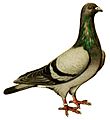Avemetatarsalians facts for kids
Quick facts for kids Avemetatarsalia |
|
|---|---|
 |
|
| Clockwise from top-left: Tupuxuara leonardi (a pterosaur), Alamosaurus sanjuanensis, (a sauropod), Tsintaosaurus spinorhinus (an ornithopod), Daspletosaurus torosus (a tyrannosaur), Pentaceratops sternbergii (a ceratopsian), and Grus grus (a neornithian). | |
| Scientific classification | |
| Kingdom: | |
| Class: | |
| Subgroups | |
| Synonyms | |
|
|
Avemetatarsalia (say "Ah-vee-met-uh-TAR-say-lee-uh") is a scientific group name that means "bird toes." It was created in 1999 for all the ancient reptiles called archosaurs that are more closely related to birds than to crocodiles. Another name for this group is Panaves, which means "all birds." This name includes all animals, living or extinct, that are more like birds than crocodiles.
This group includes the famous dinosaurs (and that means birds too, since birds are living dinosaurs!), the flying reptiles called pterosaurs, and some older, less well-known animals. Avemetatarsalians are one of the two main branches of the archosaurs. The other branch is called Crurotarsi, which includes crocodiles and their relatives.
Contents
What are Avemetatarsalians Like?
Avemetatarsalians were usually built lighter than their crocodile-like cousins, called pseudosuchians. They often had smaller heads and usually didn't have bony plates on their skin, which are called osteoderms.
Many animals in this group walked on two legs, which is called bipedal. Some, like birds and pterosaurs, could even fly! We know that many avemetatarsalians had feathers or other hair-like structures. For example:
- Pterosaurs had soft, downy coverings called pycnofibers.
- Some ornithischian dinosaurs, like Psittacosaurus and Tianyulong, had quill-like structures.
- Theropod dinosaurs (like T. rex) and their descendants, birds, had true feathers.
Most avemetatarsalians had a special kind of ankle called an "advanced mesotarsal" ankle. This ankle had a large astragalus bone and a small calcaneum bone. This design allowed their ankle to move like a single hinge, which gave them better movement. Because of this special ankle, many avemetatarsalians stood upright, with their legs directly under their bodies, much like mammals do today.
Where Did Avemetatarsalians Come From?
The first bird-line archosaurs show up in the fossil record about 245 million years ago (mya). This was during the early part of the Middle Triassic period. One of the earliest known animals from this group is the dinosaur-like Asilisaurus.
However, scientists found some very old fossil footprints in Poland in 2010. These footprints might belong to an even older type of avemetatarsalian. If they do, it would mean that avemetatarsalians appeared around 249 mya, in the Lower Triassic period. The oldest Polish footprints were made by a small animal that walked on four legs. But slightly newer footprints from 246 mya show that moderately large, bipedal (two-legged) dinosauromorphs had already appeared.
It's interesting to note that the huge Permian-Triassic extinction event, which wiped out many species, happened around 250 mya. The time when the Triassic period ended and the Jurassic period began was about 200 mya. The age of these footprints suggests that dinosaurs didn't suddenly appear. Instead, they slowly developed and became more common over a long time during the Triassic period.
Images for kids
See also
 In Spanish: Avemetatarsalia para niños
In Spanish: Avemetatarsalia para niños










